I didn’t write this article. My wife, Luba Vyaznikova, did. Luba is currently a product lead at Badoo. However, before taking this position, she had launched a very successful product. Below, she shares her story.
—Oleg
Two and a half years ago, a spark of inspiration and the passion to create something new guided me down a path to create an app with a $500,000 annual run rate.
And then, last September, Apple deleted our app from the App Store after adding its features in the new version of it iOS operating system.
But let me start from the beginning…
→ Test your product management and data skills with this free Growth Skills Assessment Test.
→ Learn data-driven product management in Simulator by GoPractice.
→ Learn growth and realize the maximum potential of your product in Product Growth Simulator.
→ Learn to apply generative AI to create products and automate processes in Generative AI for Product Managers – Mini Simulator.
→ Learn AI/ML through practice by completing four projects around the most common AI problems in AI/ML Simulator for Product Managers.
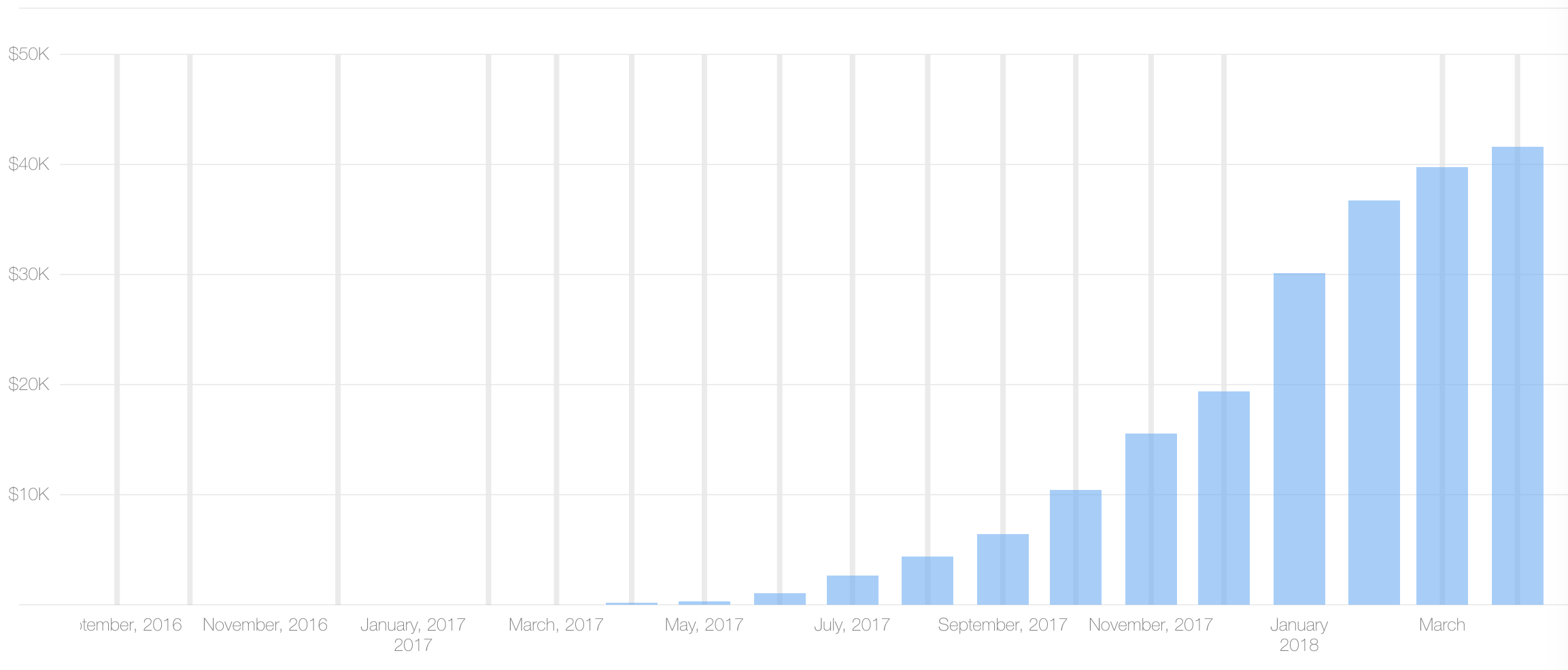
* The app’s monthly revenue since its launch (source: iTunes Connect)
Searching for an idea
In the summer of 2016, my husband and I moved from Moscow to London. At the time, I was a product manager at API.AI, a company that later rebranded to DialogFlow. In fall, Google acquired the company and asked the team to relocate to the US. But as I had just arrived in London, I wasn’t ready to make another move.
So there I was, in an unfamiliar city, without a job, without friends and without the life I knew. At first I was very frustrated and worried. I felt at a loss. But before long my entrepreneurial spirit took over and made me realize this was a great opportunity to try something new. I could make my own product from scratch, with my own rules.
I started brainstorming different ideas. During this process, I let my own everyday problems guide me: I get anxious easily, I find it difficult to decide what to wear, I don’t know which movie to watch tonight, I spend a lot of time on Instagram, etc.
I decided that dealing with my Instagram addiction would be a good place to start. I compiled a list of ideas for an app that could help tackle this issue.
I was adding all ideas to notes and one day this one came up there:
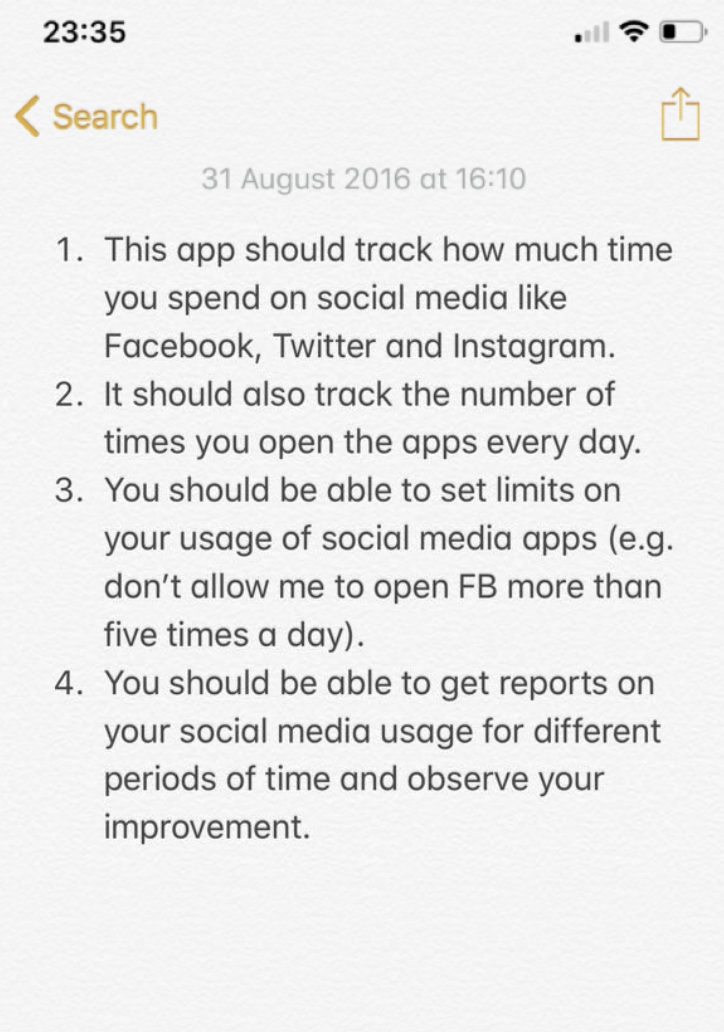
I rummaged through app stores for an app that solves this problem, but found nothing that was good enough. It was a good sign that I should dig deeper.
Validating the problem
I am a big fan of Instagram. I use it for personal purposes, but I also admire it as a product manager, understanding how carefully and masterfully it has been designed. I can spend hours there and lose track of time. I had never realized how much of my time Instagram takes every day, week, month and year.
In the age of social media addictiveness, the need for such knowledge seemed obvious to me, but it was important to make sure that other people had it as well.
A quick search revealed a lot of blogs and resources that aimed to help people reduce the time they waste staring at the displays of their mobile devices. There were a number of popular desktop services that allowed you to track time spent on social media, modified Facebook’s interface to make it less addictive, etc. There were also several popular Android apps that had similar features (recent versions of Android have features that allow you to control your screen time).
But iOS had nothing like that. I was confident that such a product would find its audience and carve its own niche. If we could find a way to provide an app with such features to iPhone users, it would become successful.
The key question at that time was: Was there a way to automatically determine how much time a user spends on Facebook or Instagram and block those apps once a limit was reached?
With this idea in mind, I went to Roman Tsopin, a former colleague at Yandex. He liked the idea and we agreed to become partners. I became responsible for the product and marketing, and Roman took control of the technology and development parts.
In search of a technological solution
Technologically, the task turned out to be difficult, but not impossible. Onavo, the mobile analytics startup Facebook acquired a few years earlier, provided very interesting hints on how we could solve this problem.
Prior to its acquisition, Onavo had developed a mobile VPN app that compressed and encrypted internet traffic and ran it through the company’s proxy servers. Users could install the app to save on their metered data plans. At the same time, the company tracked app usage and sold this analytics to other developers.
We decided to take a similar approach. We could set up a VPN service and analyze the traffic passing through our servers to learn which social media services mobile devices were communicating with, and using this data we could estimate the time spent on different services and block access to them when users exceeded their self-determined limits.
For everyone who has concerns about privacy – the app didn’t break any Apple App Store guidelines (https://developer.apple.com/app-store/review/guidelines/#vpn-apps). Sense app passed over 20 App Store reviews during almost 2 years of working on the app. We didn’t store or sell any data – we only calculated time spent on different apps and showed it to users. It was clearly stated in our T&C and Privacy policy.
I’ll spare you the details about the pre-launch with its endless tests, technical problems, interviews with our potential users, brainstorming about the onboarding, UX, monetization models and promotion strategies. It was a fascinating and a difficult journey of pure creativity with a great deal of uncertainty and doubt.
In mid-September 2016, we began the development process. In early December of 2016, the “Sense – Social Media Time Tracker” app made its debut in the App Store.
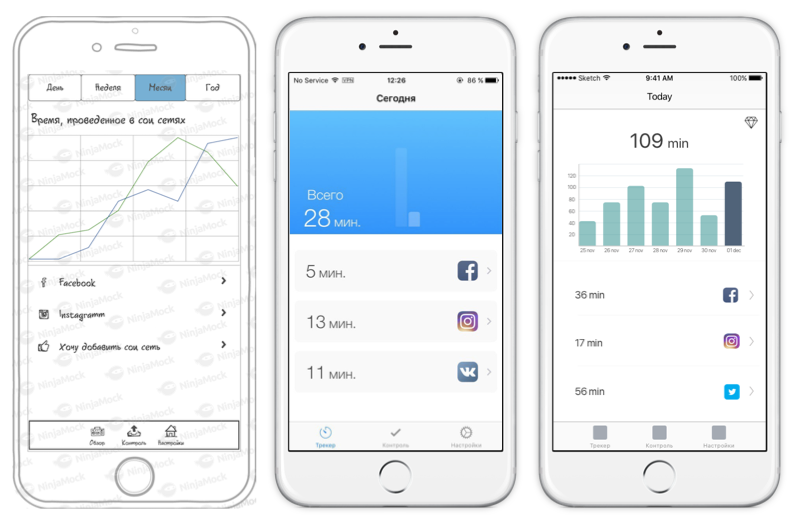
Looking for the right product
Before the launch, we considered the main risk as users’ reluctance to connect to a VPN as a requirement for the app. We thought it might look suspicious and unsafe. We were wrong. In the first version, 70% of our users successfully completed the onboarding process and started using the app.

Then it was time to deal with the retention rate. We needed to understand whether users found value in our product.
Since Sense was a background process and performed most of its functions with very little interaction with the user (tracking time spent on social media, displaying notifications about exceeding the limit, blocking access to monitored apps), we could not use app launch as the reference event for retention. Instead, we calculated retention by looking into active connections to the app’s VPN service.
In the first version of Sense, retention plateaued and stabilized at around 6-7%, a good sign that the app was solving a real problem from a specific audience.

Feedback from Sense’s users gave us hints on how we could improve the product:
- We needed to learn to track more social media channels. In the beginning, we only tracked Facebook, Instagram and Twitter. Later we added Snapchat, Pinterest, Reddit, and YouTube to the list of supported platforms.
- We had to increase the app’s speed. In the early days of Sense, poor geographical coverage of our servers caused our VPN to slow down users’ internet speed in some remote regions. To solve this problem, we deployed new servers in regions we considered our key markets.
- There was a need to increase tracking accuracy. This was one of the most difficult and important tasks we had, since we had built the key value of the app around this feature. To improve the quality, we used automatic methods to determine the accuracy of our estimates, and we also had several people manually track the time they spent on social media every day and compare their results with the values the app displayed.
- In addition to tracking the time spent on social media apps, we needed to implement the feature to block those apps when the user reached the configured time limit. This feature created a “wow” effect and made our product stand out from the competition.
We solved all the key problems in the first few months of 2017. As a result, retention rate began to plateau at 10%, a 66% improvement from its previous state!

But the product still withheld a lot of undiscovered potential and opportunities. From the feedback and correspondence of our users, we learned about a lot of use cases we hadn’t considered at the time of our launch. But at that stage, we were satisfied with the level of retention we had, and therefore decided to switch our attention towards seeking growth channels.
The huge costs of running VPN server
To manage growth, we needed to find efficient distribution channels, and we also had to find a way to cover the huge costs of channeling users’ traffic through our servers. So we started experimenting with monetization.
First, we added an in-app purchase that cost $5. This purchase gave users access to premium features such as getting reports on social media usage history, and setting a daily limit for social media apps and blocking them when the limit expired. The conversion to purchase rate was 6%, and LTV was about $0.2 net considering Apple’s 30% commission fees and ignoring server costs.
The figures looked promising, but the one-time purchase didn’t cover the server costs, since a significant part of the users stayed in the product for a long time without paying anything.
The next step was to test a subscription model for accessing the premium features. By the end of the fourth month, LTV doubled compared to the previous version. However, it still wasn’t enough to cover the cost of non-paying users, which comprised the majority of the product’s MAU.
It became clear that distributing the basic version of the product for free wouldn’t work. We decided to test the subscription model with a free trial, offered immediately after the app’s install.
This allowed us to solve the problem of paying for the servers, since in this model, we were only offering seven days of free usage. It was no longer necessary to provide a free VPN service to the non-paying users, who previously comprised 95% of the app’s audience.
This model also allowed to discard unmotivated users who came to the product out of curiosity instead of having a real problem to solve. As a result, we managed to grow the four-month LTV by 50%.
The only drawback was that we began to receive a lot of negative feedback. People complained about the need to pay for the product. Well, I guess we lost this one battle, but we won the war.
ASO + Search Ads = ?
Our next step was to find out how we could reach out to the users who needed our product. Solving this problem proved to be more challenging than anything else we had done before.
We tried many things. First, we tested paid acquisition through Facebook and Instagram ads. But we found out that it would take at least 16 months to break even on the costs of the ad campaign. Also, the traffic we received was limited to a couple of hundred downloads per day even at a high CPI (cost per install).
Then, we tried working with influencers and thought leaders. Our downloads saw a sharp spike after an influencer shared the app in social media. But we failed in our efforts to directly cooperate with other influencers.
And so we continued our search for growth channels.
We mulled over the idea of launching a blog, but did not see any opportunity to win the competition for SEO traffic against bigger websites. The problem was that the traffic was concentrated on a small set of queries.
Several exhausting experiments later, we finally found a working distribution channel. It turned out to be a smart combination of Apple Search Ads and app store optimization (ASO).
We started using Search Ads immediately after the launch; it was an efficient way to quickly bring enough new users to evaluate changes in the product. At that time, CPI was standing at about $0.93. It seemed impossible that we would ever be able to increase user LTV to achieve positive ROI.

We were hoping that once a new monetization model was implemented, we could reach positive ROI. The predicted LTV reached $0.6 after four months. Our server costs dropped dramatically after cutting off the non-paying users.
As a result, after all the optimizations and tweaks, we managed to achieve ROI > 0. Admittedly, it wasn’t quite the classic way of doing so. And here is why:
- Based on the first Apple Search Ads campaign, we had thoroughly studied the structure of search keywords relevant to our app. We knew where the traffic was, how much the install would cost for each keyword, and how we were converting and retaining users who came from each keyword.
- When we began working on the Search Ads channel, we started with keywords that were not too competitive but had enough traffic to bring us many users and draw us close to ROI > 0.
- Next, we changed the name of the app and its short description, optimizing them for the keyword we had chosen. This adjustment made it possible to give a 50% boost to the overall conversion rate in the acquisition funnel for the traffic that came from this keyword. As a result, we often achieved ROI > 0 right after this change.
- We made another important observation: As our downloads from a specific keyword grew, our rating in organic search improved as well and we started receiving more free downloads.
- We developed a recurring process for each keyword. First, we changed the name of the app to adjust for the specific keyword we were targeting, and then we ran an Apple Search Ads campaign. Once we ranked high in organic search for this keyword, we switched to the next one while continuing to support the previous ones with paid traffic.
The process described above allowed us to significantly improve the performance of the acquisition funnel, and most importantly, to increase organic traffic. The growing income from the organic users allowed us to get engaged in more and more highly-rated keywords while maintaining positions of the search queries we had already won.

By May-June 2017, we had developed the first growth channel we could understand and scale. We continued working on the product and on the acquisition funnel, which over time allowed us to raise downloads to around 1,000 downloads per day (~30,000 per month). This wasn’t bad for a niche product like ours.
After almost half a year of little progress in bringing in new users, we finally felt the joy of having something in place that worked consistently. We realized that we could grow, and that the product had great potential. In the long run, it’s all about keeping faith and not quitting when something doesn’t come your way.
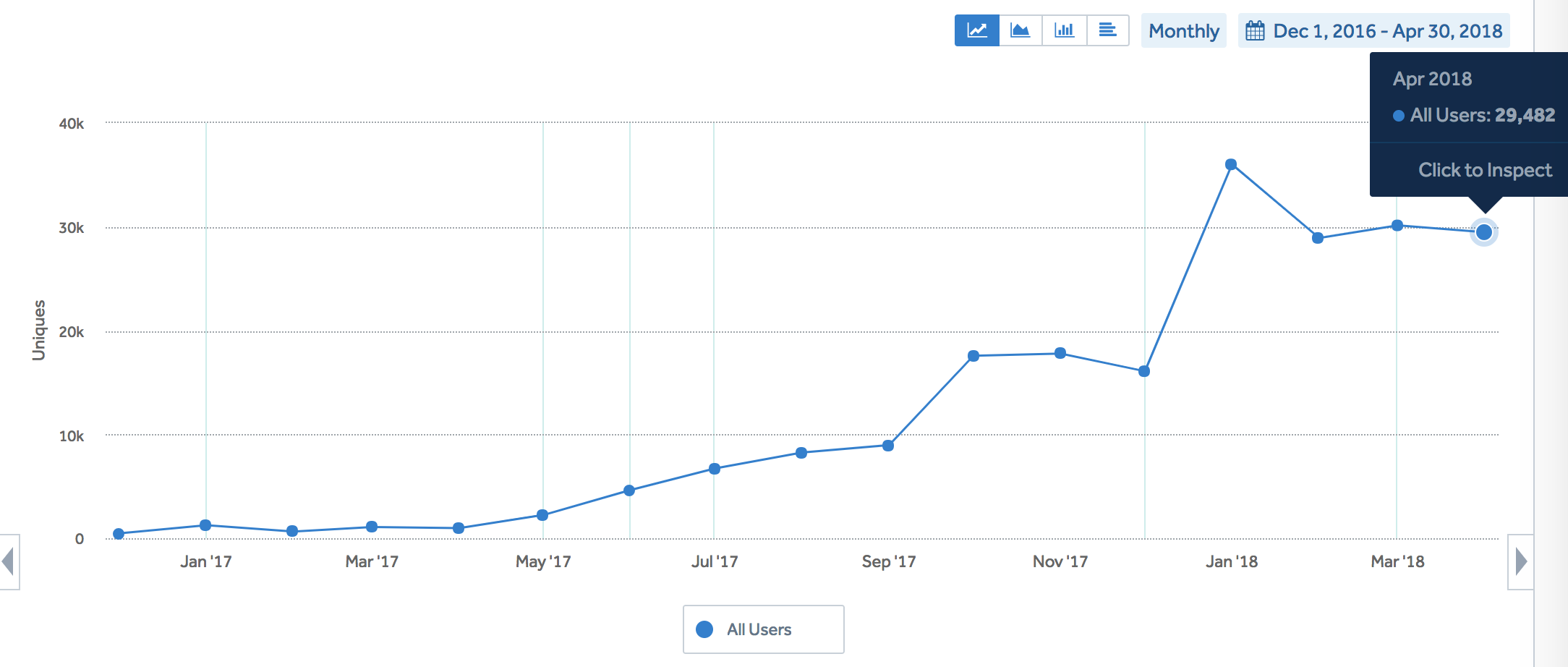
Rapid growth, former president of Pinterest, competing with the start-ups and industry giants
With our growth model figured out, we began to grow rapidly. What we didn’t know was that we had more interesting things coming our way.
Media outlets started writing about us. We were mentioned in podcasts. The product began to spread like a bushfire on social media.
Someone even added us to Product Hunt without us knowing it. We found out by happenstance, when stumbling upon Product Hunt’s featuring on Facebook.
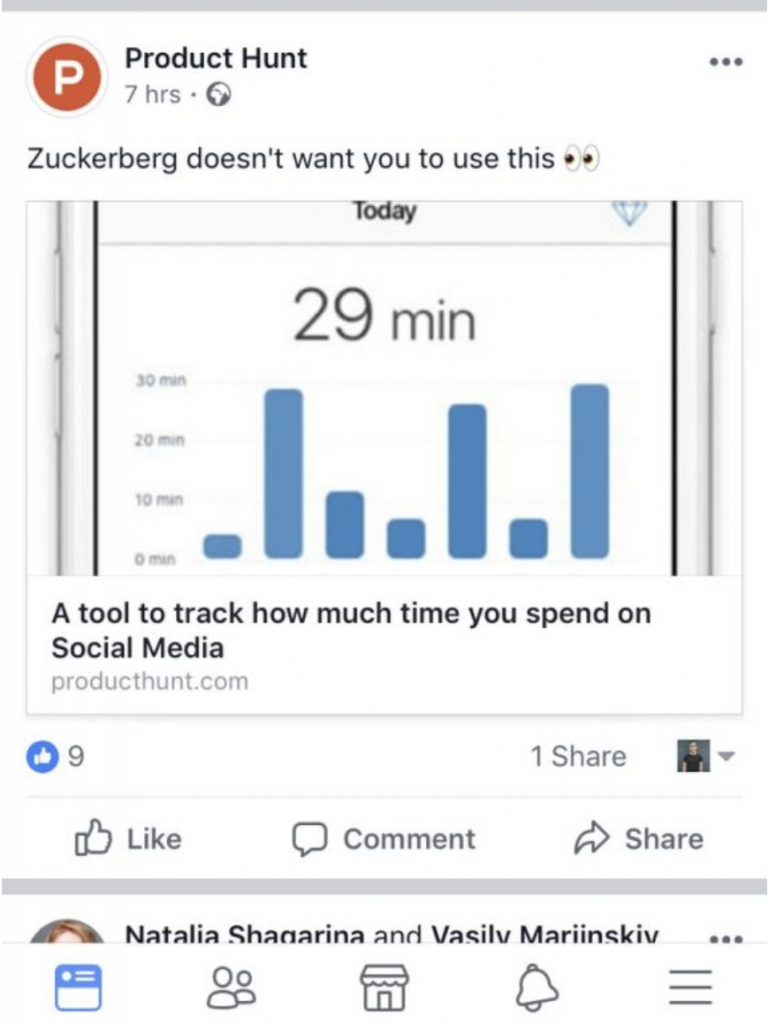
One evening, we got an email from Tim Kendall, who had recently quit Pinterest as its president and was now founding his own organization. He had been thinking about creating a similar product to help people spend less time on their phones. Then he found us and wanted to discuss a potential partnership. At the time, Sense was already a profitable product, so we didn’t need funding. But only a fool would refuse such a conversation. It was nice for a small team like ours to get such attention.
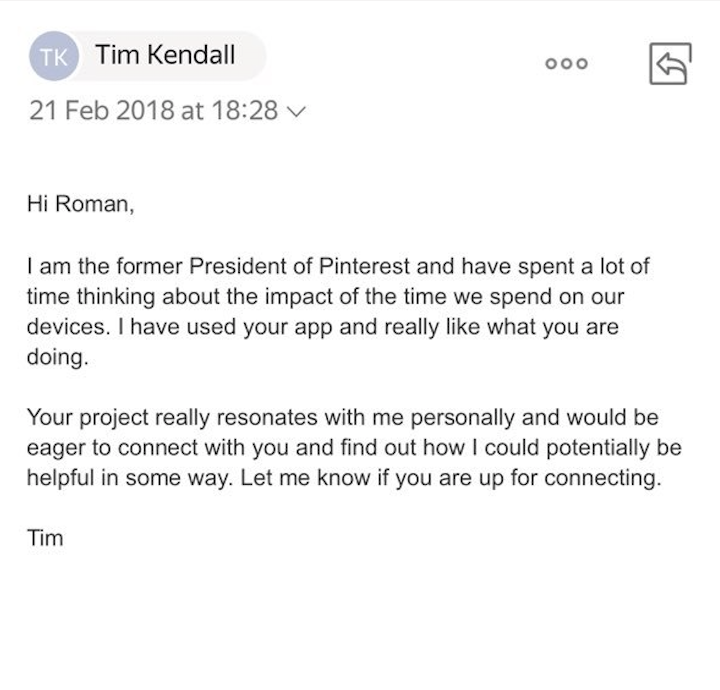
However, there was also a negative side to our rapid growth and the attention we were drawing to ourselves. Before long, we began to notice competitors who tried to copy us. Some even had the audacity to directly come to us for advice on what technology was best to launch a similar product.
Some of these competitors even raised investments with insane valuations ($10-15m) and then used this money to warm up the advertising auction and raise the prices for search ads, which slowed down our growth.
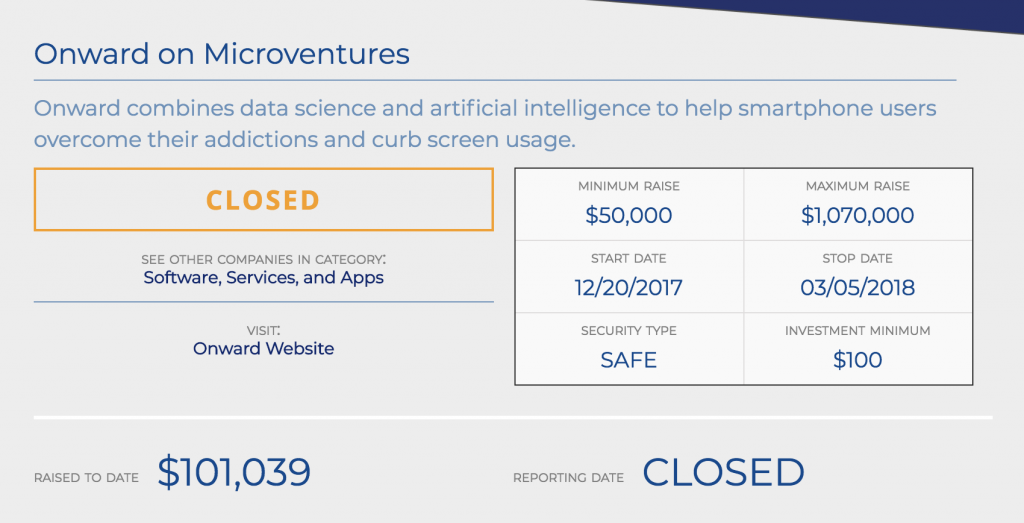
While competing with the startups wasn’t pleasant, yet we managed to cope with them, because the quality of our product was better. But then the giants entered the arena. At first, Facebook announced that it would add a time-tracking feature to Instagram. And then Apple announced a new feature, Screen Time, which would ship with the iOS 12 update: The feature allowed users to track and set limits on the time they spent in different apps.
Endgame
After announcing Screen Time, Apple became very hostile towards us and other similar apps.
First, the App Store team became slower and slower in reviewing our app updates. It often took a month and sometimes even two.. Then we started getting rejections on app updates for odd reasons, and the reasons changed each time we appealed to the Apple review team. In the end, Apple stated that we were not using our VPN for its intended purpose. But we never understood how they could define the purpose of a technology they didn’t even create in the first place.
We received many emails from our competitors. They were faced with the same aggressive behavior from Apple and wanted to somehow influence the tech giant by submitting a collective complaint. Unfortunately, this struggle and the long discussions that ensued did not bear fruit.
In early September, Apple removed our app from the App Store. The following week, Apple released the new iOS with the Screen Time feature.
Final words
Sense was downloaded over 400,000 times during its short existence. A month before being removed from the App Store, the app raked in ~$45,000 in revenue. This means the product was operating at a $500,000 annual run rate.
We launched our app time-tracker one-and-half years before it became a trend, and then Apple and Facebook made similar products.
Although the endgame was bitter, yet the experience of launching my own product was invaluable. My main takeaway is that you shouldn’t be afraid to build your own thing from scratch—find new experience in unexplored areas. You can make a successful product with a very small team (just 2 people) and even without any external funding.
And never stop believing, even in times when things don’t go your way. There were many times when I thought that nothing would work out and we were at a dead-end. But by a quirk of fate and a bit of ingenuity and persistence, we managed to find a way forward.
It was an unforgettable adventure, and I am looking forward to the next one to come.
For everyone who has concerns about privacy – the app didn’t break any Apple App Store guidelines (https://developer.apple.com/app-store/review/guidelines/#vpn-apps and https://developer.apple.com/news/?id=06032019j) and passed over 20 App Store reviews during almost 2 years of working on the app. We didn’t store or sell any data – we only calculated time spent on different apps and showed it to users. It was clearly stated in our T&C and Privacy policy.
The author of the article is Luba Vyaznikova.
More about app revenue.
→ Test your product management and data skills with this free Growth Skills Assessment Test.
→ Learn data-driven product management in Simulator by GoPractice.
→ Learn growth and realize the maximum potential of your product in Product Growth Simulator.
→ Learn to apply generative AI to create products and automate processes in Generative AI for Product Managers – Mini Simulator.
→ Learn AI/ML through practice by completing four projects around the most common AI problems in AI/ML Simulator for Product Managers.









